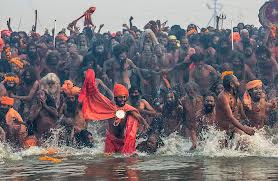The first “shahi snan” (“royal baths” at the sangam by saints and sadhus of the 13 akharas) began at 5 am in the morning with the “naga sadhus” leading the way.
The near naked and ash smeared naga sadhus blew conch shells and danced as they moved towards the sangam bank. The “Mahanirvani” and “Atal” akharas were the first to take a holy dip followed by the “Niranjani” and “Anand” akharas. Then, other akharas took turns to take a bath in the holy waters.
Devotees braved the chilly weather conditions to take a holy dip at the 18 “ghats” (banks) along the sangam. Crowds started gathering at the sangam area since Sunday evening. Security personnel had a tough time controlling the surging devotees who thronged the sangam banks at dawn.
At one point, the situation threatened to go out of control when the crowds stayed on the banks, blocking the way for the other devotees. Senior police officials reached the spot and made the crowd to leave the bank to pave way for the incoming devotees.
“By evening, an estimated 10 million devotees had taken bath on the occasion of Makar Sankranti,” officials said, adding that the number devotees from abroad was also formidable.
A battery of mediapersons, both national and international, captured the bathing by the naga sadhus. The administration had made special arrangements for the mediapersons to cover the congregation.
The Mahakumbh, held every 12 years, is a 55-day event during which as many as six shahi snans will take place. The next royal bath will take place on “Mauni Amavasya” (Februrary 10) followed by “Basant Panchami” (Februrary 15).
The other important days for the Maha Kumbh are “Pauash Purnima” (January 27), “Maghi Purinma” (February 25) and “Maha Shivratri” (March 10).
Tight security arrangements have been made keeping in view the threat perception from terrorists.
According to sources in the state Home Department, the Intelligence Bureau (IB) has alerted the police on possible terrorist threat to the mela. Teams from the National Disaster Management Authority, bomb disposal and anti-sabotage squads have also been deployed.
Additional Director General of Police (Law and Order) Arun Kumar said 30 police stations and 40 outposts have been set up at the place and they are being manned by 50 inspectors, 550 sub-inspectors, 450 head constables and 5,800 constables.





Comments
Add new comment